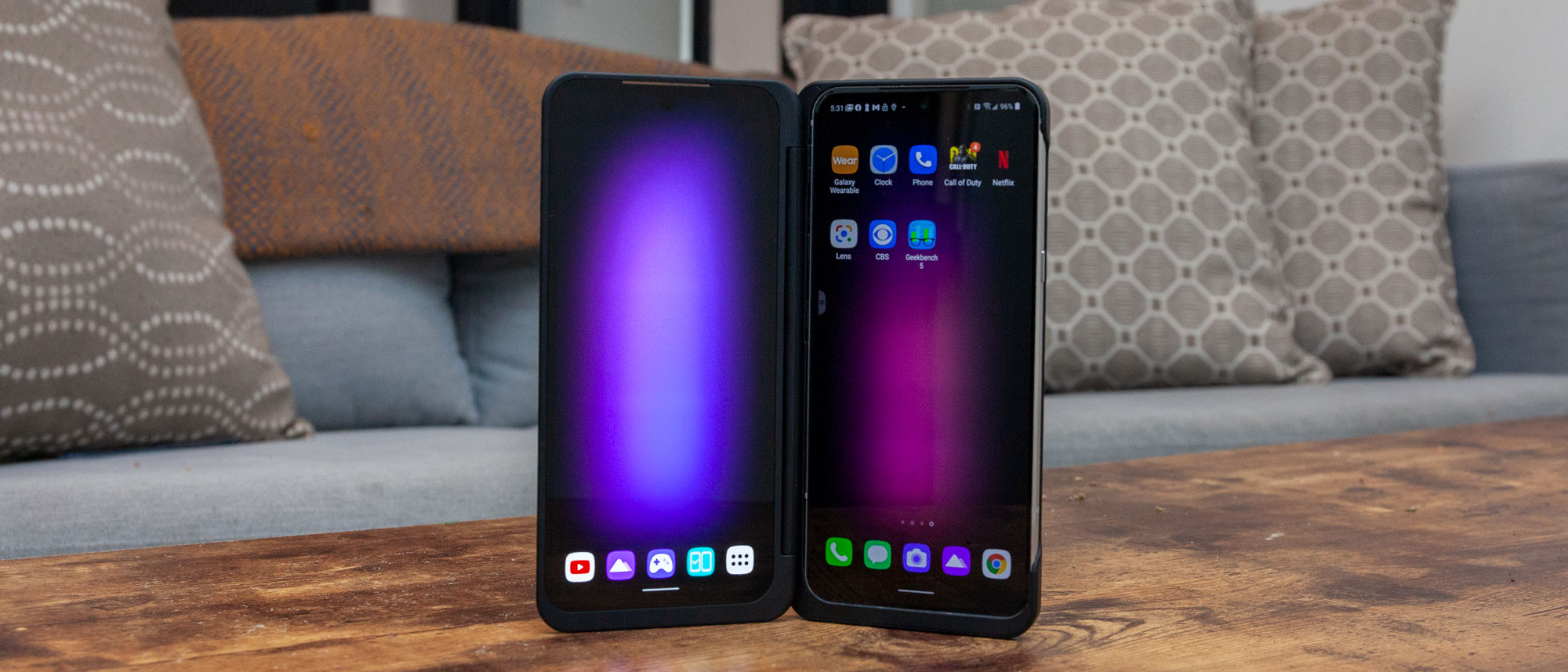TechRadar Verdict
The LG V60 is the most refined flagship we've seen from LG, and with its free Dual Screen peripheral/case, 5G connectivity, and good specs, the phone stands out from its rivals. But its extra display space is clunkier in execution than foldables out there, leaving it more appealing to niche consumers. Still, as one of the more affordable 5G phones out there, the LG V60 has appeal for the average consumer, even if it doesn't outperform other flagships.
Pros
- +
Dual Screen is great affordable extra display
- +
Affordable 5G
- +
3.5mm jack
Cons
- -
Not the highest-tier flagship specs
- -
Unimpressive cameras
- -
Lack of dual-screen app support
Why you can trust TechRadar
Two-minute review
LG’s flagship V series of phones has traditionally been content to mimic the features, but not the extensive flash, of other leading flagship devices. That’s changed with the LG V60, which has more style, and some unique features to help it stand apart from the crowd.
Whether those perks are enough to give it the edge over the best phones on the market is more a matter of personal taste than a specs comparison. The LG V60 is a decent flagship in its own right, but the detachable Dual Screen paired with it is a novel accessory that may seriously appeal to the multitaskers, gamers, and screen fiends of the world.
For these users, the LG V60 meets a need for more screen space at a relatively affordable price, although there are compromises compared to the seamless screens on foldable phones. Go in with measured expectations, though, and the V60 is a capable phone that’s great for enjoying media.
Despite not having quite the highest specs, the V60's Snapdragon 865 and 8GB of RAM with a 5,000mAh battery ensured we were watching media and playing games for quite awhile without any noticeable slowdown, even while we were engaging the second display. Just don't plan on taking a lot of long-distance photos, as this phone lacks a telephoto lens; instead, keep the still shots close, and the video even closer to see where its camera performs best. The LG V60 can record in 8K at 24fps with four microphones to catch surround-sound audio.
The V60 is also one of the more affordable 5G phones thus far. This year’s crop of flagship Android handsets packing Qualcomm's Snapdragon 865 chipset bring with connectivity to the budding next-gen networks – and a comparative price bump. While the V60 misses out on a few of the nicer perks of the comparably-sized Samsung Galaxy S20 Plus (like 12GB of RAM and triple-rear cameras), it’s also notably cheaper.
Overall, the V60 packs enough perks to differentiate itself from the competition, but not quite stand out: not everyone is going to want a Dual Screen, although they might like the idea of 8K video, or 5G at a lower price.
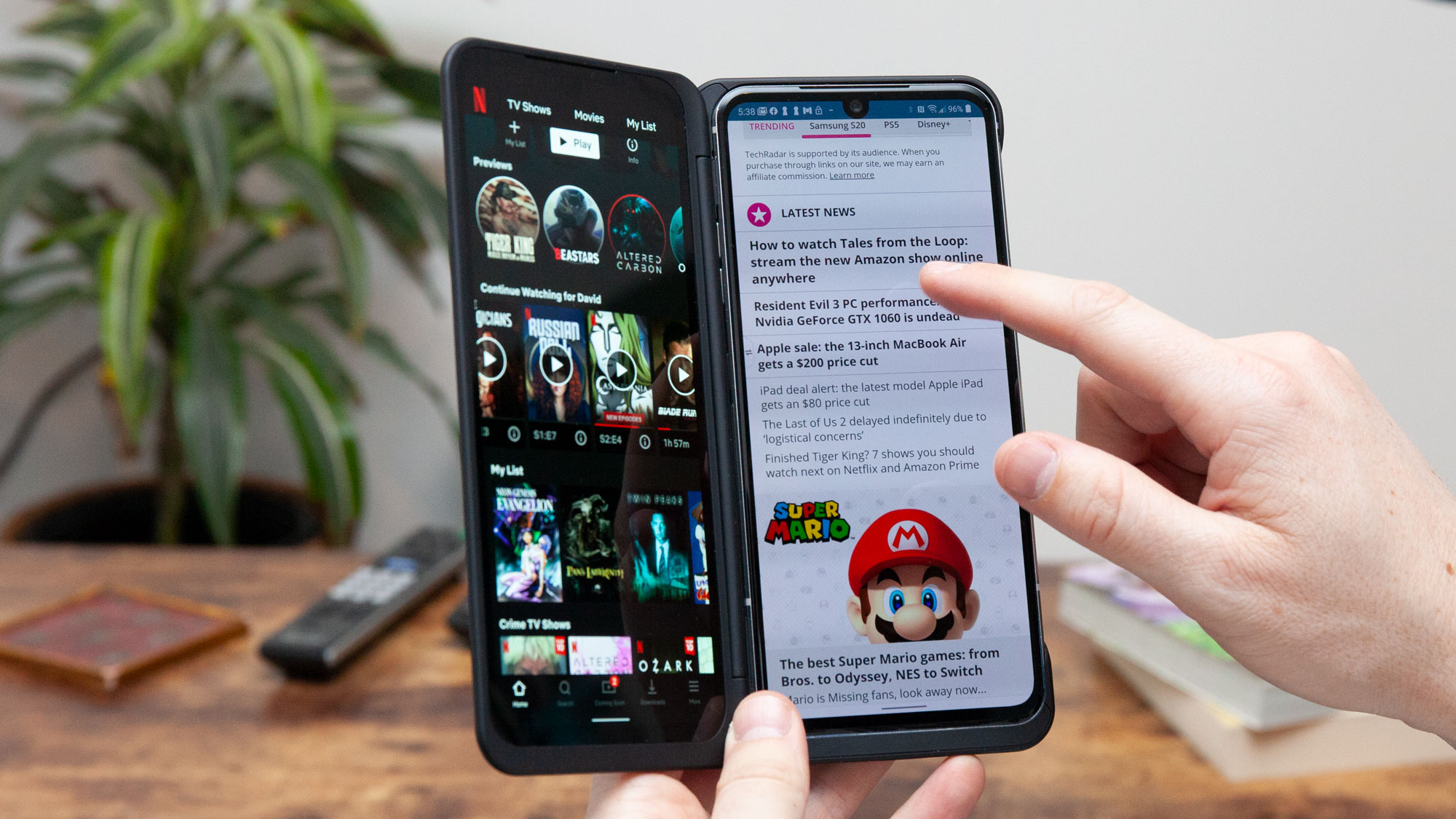
LG V60 price and release date
The LG V60 was due to be unveiled during MWC 2020, but following the show’s cancellation at the beginning of the coronavirus outbreak, LG opted for a low-key online launch – something many other brands have imitated.
The LG V60 officially released in the US on March 16, retailing for $899 (UK and AU pricing TBC). As has been the case with previous LG flagships, this price includes the Dual Screen peripheral.
Most versions of the LG V60 will be 5G-capable, with support for the sub-6 range of frequencies. In the US, this includes the models going to carriers AT&T, T-Mobile, and US Cellular. Another version that supports both sub-6 and the higher mmWave frequencies will be available from select carriers like Verizon.
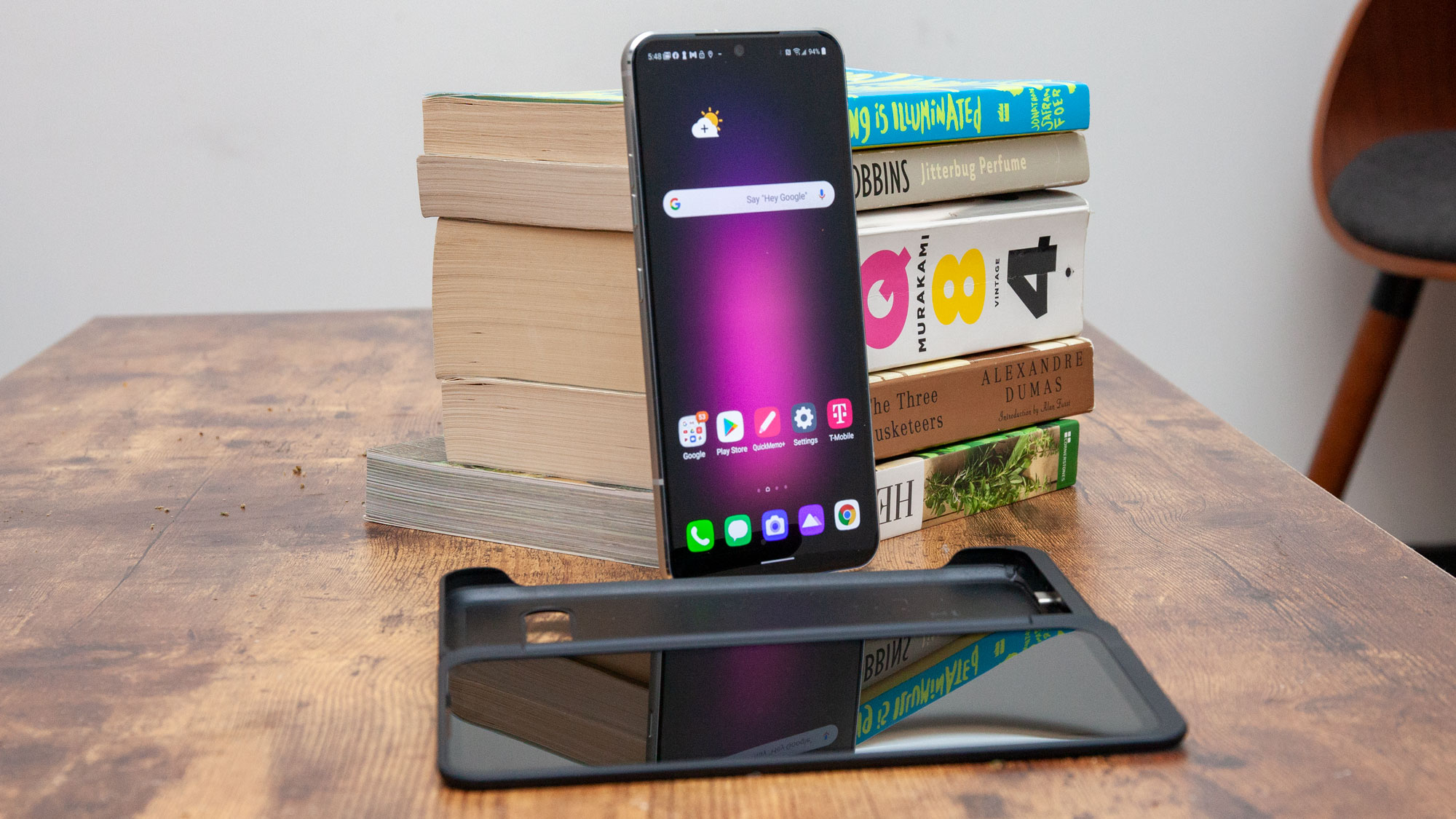
LG V60 design
The LG V60 is a confident step beyond the conservative black rectangle designs of its predecessors and into more stylish territory. By itself, the phone has looks we’d expect on a Samsung flagship, including a pearl-hued glass back, gold-ish trim around the camera bump, and burnished aluminum sides.
It’s not quite surpassing other top-tier phones in looks, with thicker bezels than you’ll see in the Samsung Galaxy S20 line, and a teardrop notch where those phones have a small punch-hole for the front-facing camera, but the phone certainly looks more impressive than previous LG flagships.
In a departure from its predecessors, the LG V60 is closer to the size of other ‘Plus’-
monickered phones, with a 20.5:9 ratio display that makes it easier to handle than, say, an iPhone 11 Pro Max.
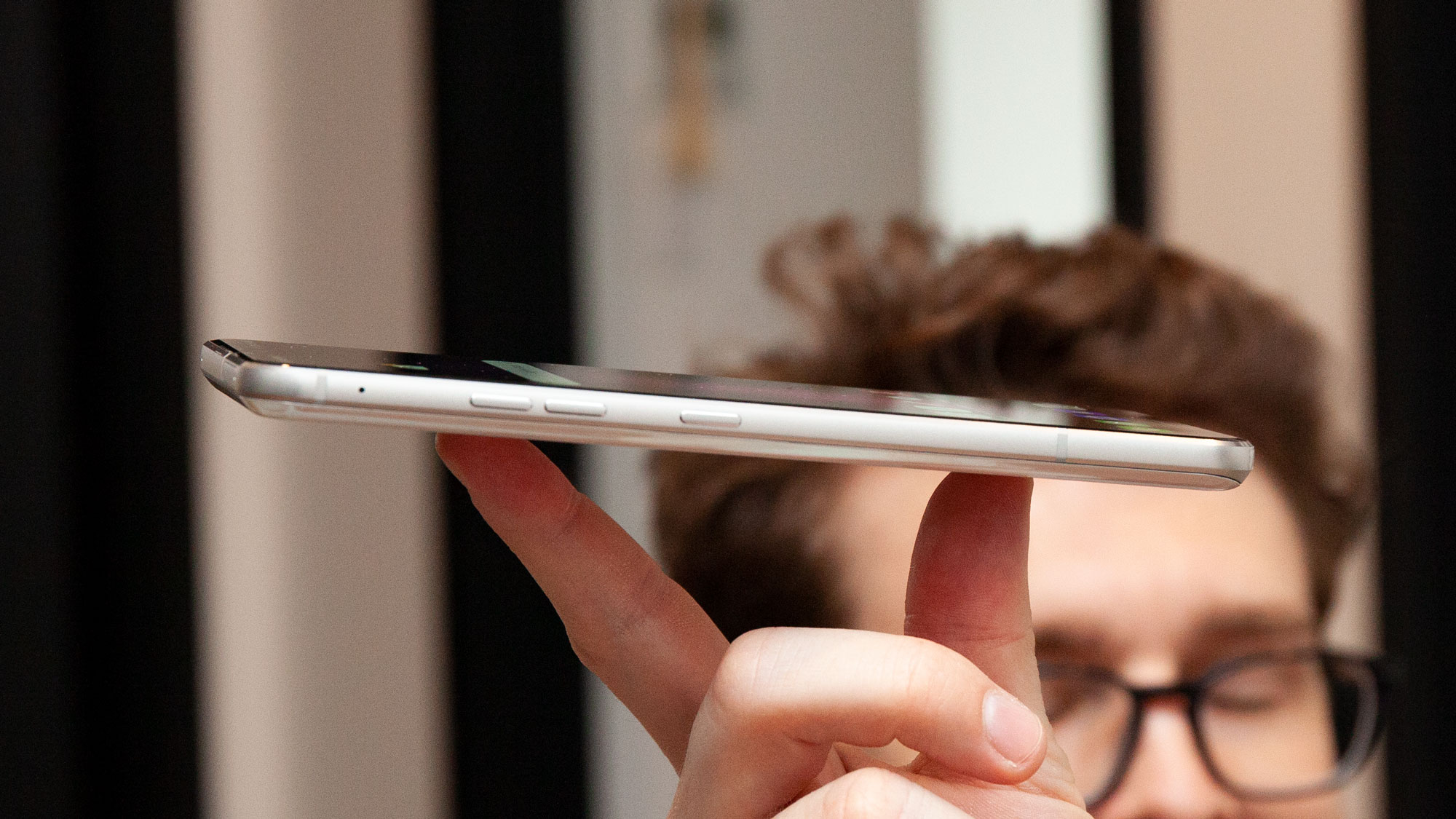
It’s still a bit thicker than other phones – its 8.8mm thickness is a bit more than the Samsung Galaxy S20 Plus’ 7.8mm – but the glass back curves gradually into the sides, giving more grip than phones with more abrupt rear-to-side curvature.
The phone loads most of its buttons on the left side, including volume up and down buttons and a Google Assistant button, with the lock button on the right side. The SIM and microSD slot is at the top, while a USB-C slot sits in the center of the bottom, flanked by a speaker and – yes – a 3.5mm headphone jack.
The rest of the design’s quirks lie in the Dual Screen itself.
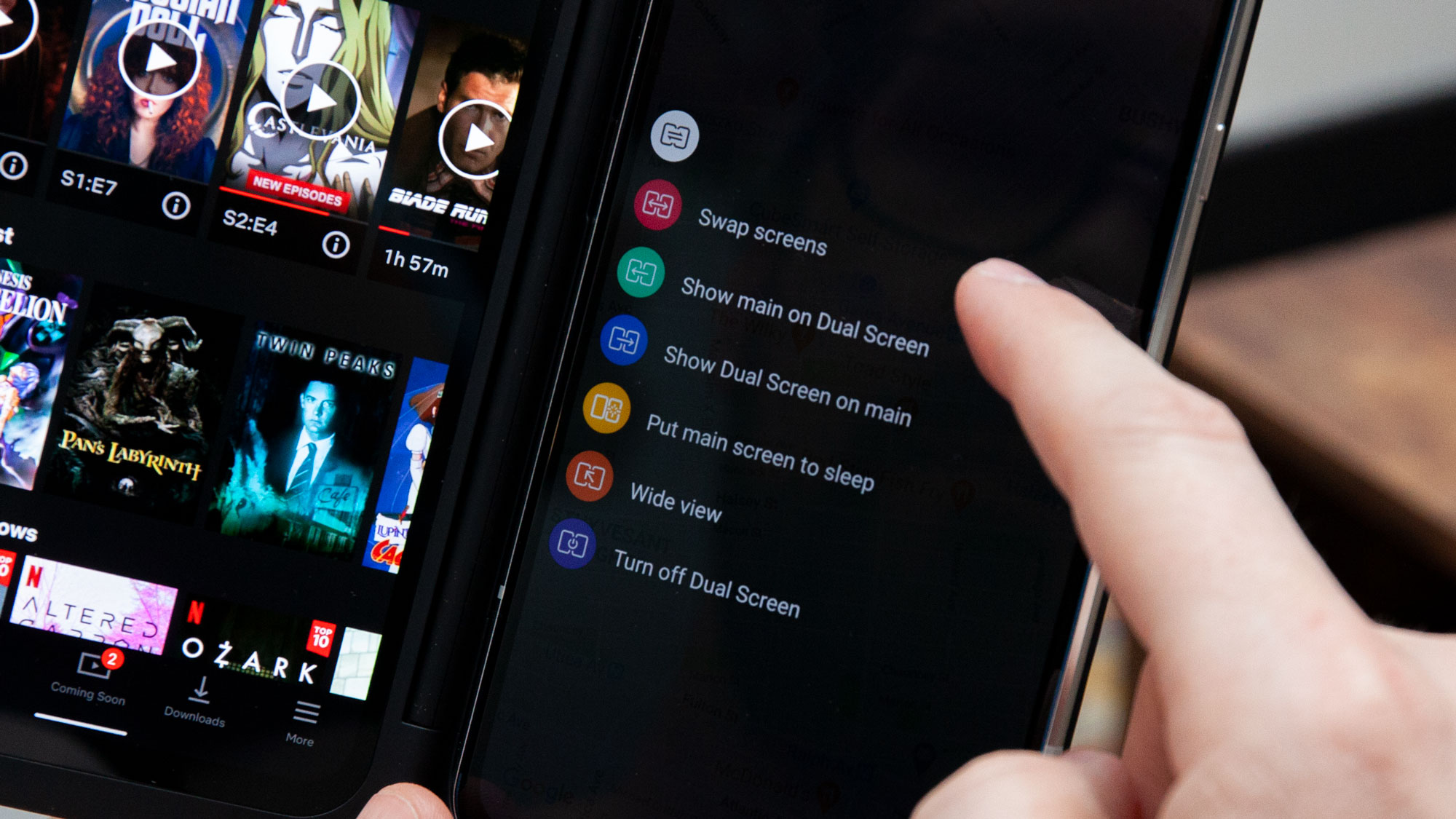
LG V60 Dual Screen
The LG V60’s standout feature is the Dual Screen, which functions much like the identically-named peripherals that come with the LG V50 ThinQ and LG G8X ThinQ. The Dual Screen works like a firm folio case, opening up to reveal a second display with the exact same dimensions as the V60’s screen – plug the phone into the Dual Screen’s USB-C plug and snap it into place, and voila, you have twice the screen real estate.
To turn on the Dual Screen’s display, you tap the small white dual-arrow icon (by default this is on the right side of the display) to expand a small menu with options to swap screens or to put the main screen to sleep – if, say, you wanted to watch media on the second display and dim the first to save battery.
Doing the above might be useful since, as it’s an unpowered peripheral, the Dual Screen runs off the LG V60’s battery, and predictably, using it drains the battery, even more so if you’re running a demanding task like watching media; this can be mitigated in the usual ways, by dimming the brightness of either display. The Dual Screen will automatically turn off when the battery drops to 10% so that you don’t fully deplete your phone, although that will also close whatever app you’re in (RIP my PUBG match).

(A quick note: since the V60’s USB-C port is blocked when plugged into the Dual Screen, you can recharge it via a pass-through dongle that magnetically snaps to the bottom of the case. This clings on with much stronger magnetism on this phone, making it less of an awkward compromise than the weak magnets for the same component on the LG G8X.)
So what’s the Dual Screen useful for? Most often, just for having two apps open at once, so you don’t have to switch as often. Whether it’s a chat conversation, your Twitter feed, or a YouTube/Netflix video you don’t want to pause, the Dual Screen is handy for multitasking, even if it’s just to streamline media consumption.
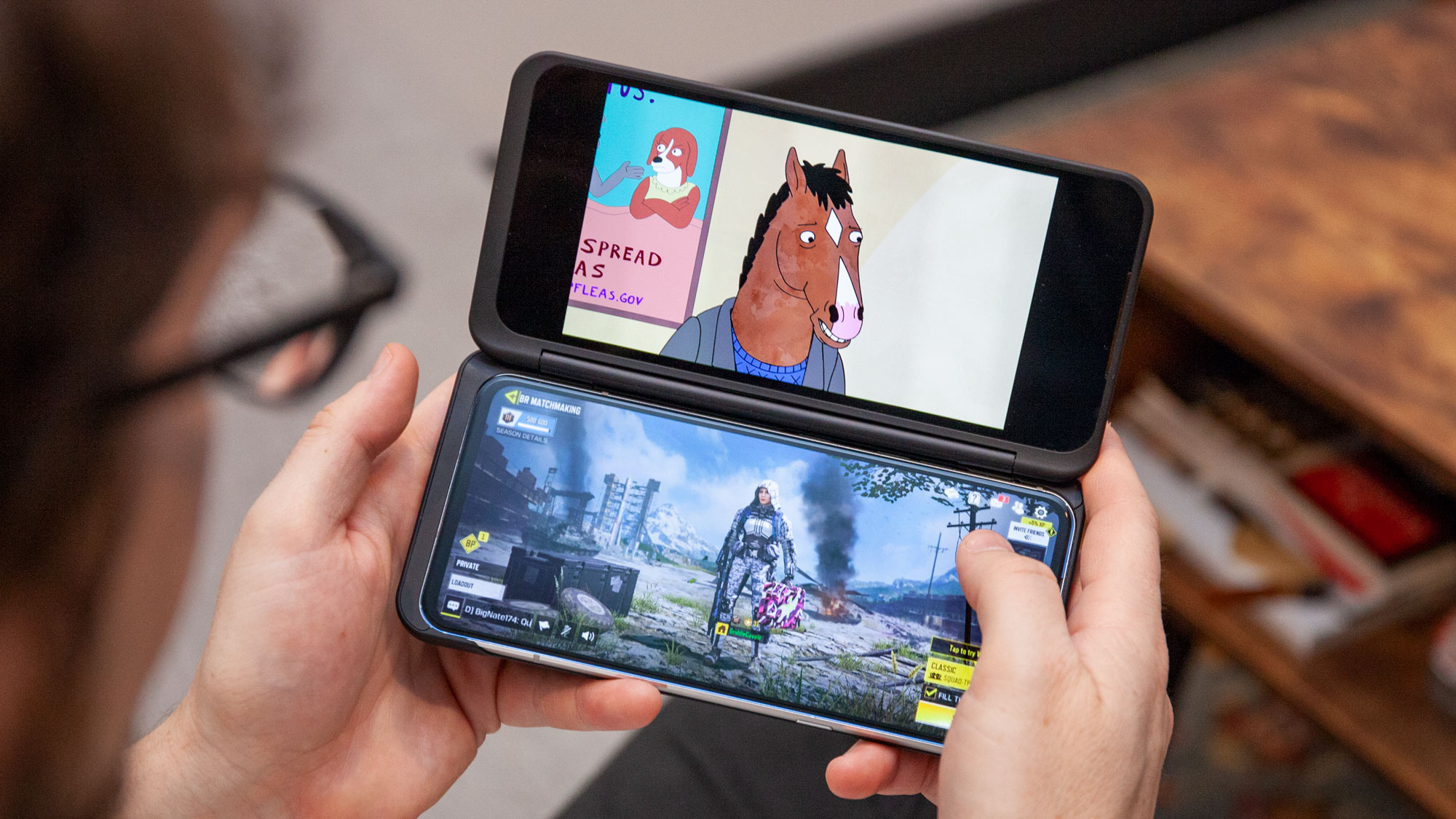
The folio aspect comes in especially handy for watching media, as you an unfold it like a clamshell or fold the secondary screen behind the main display, tent-style – either way, the phone is propped open for viewing shows or YouTube videos, or for video chatting.
The Dual Screen’s display has the same teardrop notch as the V60’s main screen, even though it doesn’t have a front-facing camera – this might seem an odd design choice, but it turns out that this makes it easier to swap apps from one display to the other. Like most notches, you won’t notice it’s there after a while, especially as most media players will hide it behind vertical bars.
The good news is that the Dual Screen comes free of cost, meaning you get two screens for the price of one flagship. The bad news? If you’re expecting a next-gen expanded display experience akin to that of a foldable phone… don’t. There’s a sizeable gap between the V60’s screen and the Dual Screen, and they’re separate screens, each of which can display one app at a time.

There are a few exceptions: apps that display across both screens, including LG’s proprietary Whale web browser, as well as several games and most of Google’s app suite. However, while some of these are neat to play with, the gap between the screens is cumbersome, meaning only some apps, like Google Maps, are useful to view this way.
Conversely, the two screens can be used for gaming, with the top display running the visuals while the bottom is used as a gamepad. The big advantage, of course, is that your thumbs won’t get in the way of the action. Racing simulators work best in this way thanks to a preset button layout geared toward games of that type, but other titles like PUBG or Call of Duty: Mobile require you to configure a custom gamepad – and even those are finicky.
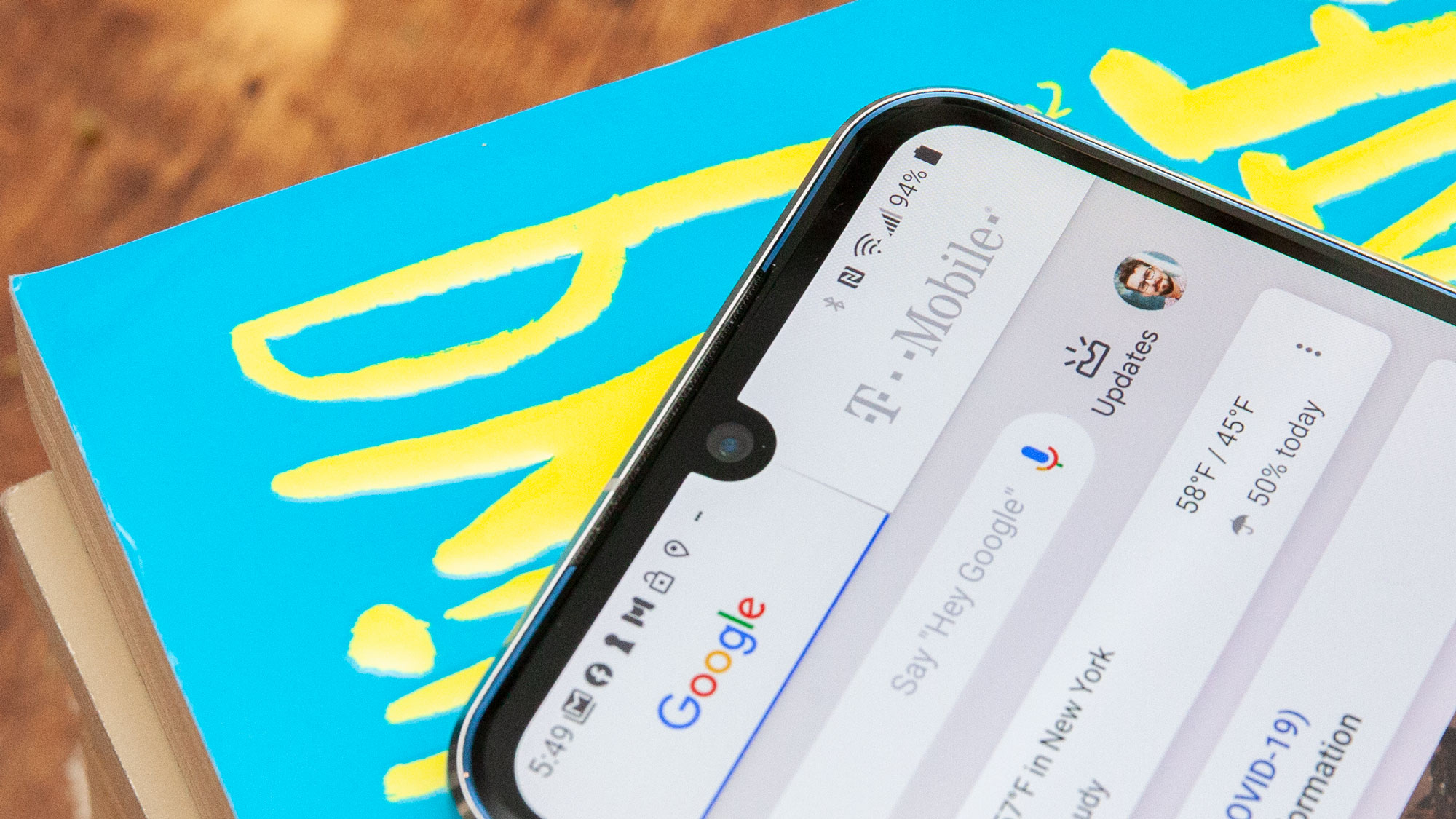
LG V60 Display
The LG V60 packs a 6.8-inch OLED display with a narrow 20.5:9 ratio. While its FHD+ resolution (2460 x 1080) is technically less dense than the WQHD+ (3200 x 1440) panels on the Samsung Galaxy S20 line, we didn’t notice much of a difference, certainly with lower-resolution media, like that shown on Netflix or Hulu, anyway; in side-by-side comparisons with an iPhone 11 Pro Max and Galaxy S20 Plus, though, the V60’s display held up in terms of sharpness but exhibited some occasional issues, such as bright skies that were blown out instead of being rendered as subtle color gradients.
In other words, it lacks a bit in terms of dynamic range, but you’d only notice in side-by-side comparisons. The V60’s display supports HDR10+ for a bit more clarity in movies and other media, which keeps it more on par with displays on other flagships.
The V60 has an in-display fingerprint sensor, and, like those on previous LG phones, it’s not quite as good as those on competing handsets – and not nearly as accurate or receptive as fingerprint scanners located on the back or chin of the phone.
When the Dual Screen closes, of course, the display is covered – so there's a small external screen on the front of the folio case. It's about as big as an outstretched finger and only displays in digital monochrome, so don't expect to use it for more than checking the time, caller ID, or app notifications. Just don't expect to be able to preview texts or messages.
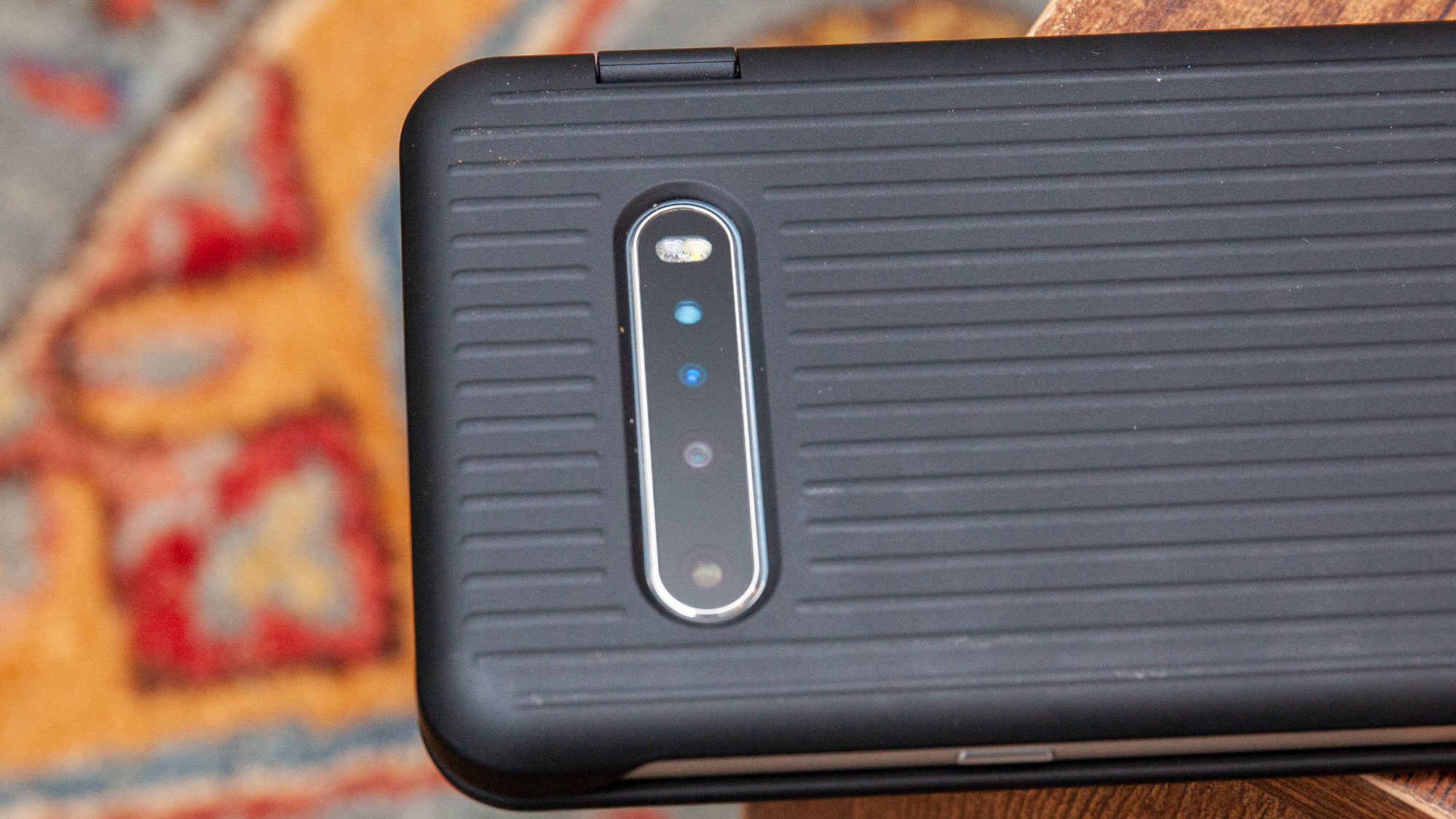
LG V60 Camera
The LG V60 packs a respectable camera array, although it’s less impressive than the industry-leading setups like those on the Samsung Galaxy S20, for instance. There are just two rear cameras here, with no telephoto lens nor any sort of depth sensor.
The LG V60’s 64MP f/1.98 main shooter is a capable lens with a 0.8-micron sensor that can maximize light in photos by ‘pixel binning,’ a process that combines four pixels into one. Doing this reduces the resolution of the main lens’s sensor to 16MP but effectively expands the lens’ sensor to 1.6 microns, resulting in less sharpness but greater light absorption.
Without an optical telephoto lens, the LG V60 relies on ‘crop zoom’ that maxes out at 10x by essentially cropping in on a portion of a photo taken by the main camera: this works much like the digital zoom capabilities of other flagships with high-megapixel sensors.
The V60’s other rear camera is a 13MP f/1.9 ultra-wide shooter that captures a 117-degree field of view. That’s a bit less than the widest-angle camera we’ve seen on a phone, the 123-degree ultra-wide camera on the Samsung Galaxy Note 10 series.
Round the front, the V60 has a 10MP f/1.9 selfie shooter.
The phone’s outstanding feature, cameras-wise, is its ability to capture video at 8K at 24fps (a 7680 x 4320 resolution), matching the Galaxy S20 line, with LG’s ‘Steady Record’ technology on hand to stabilize footage.
Another plus for video: the V60 has four mics (one pair at the top and another at the bottom) for a bit of a surround-sound effect when recording, which LG cutely calls ‘Voice Bokeh.’ LG believes content creators will get the best use of this, but it will certainly be a nice addition for anyone shooting video.

LG V60 performance
The LG V60 packs an octo-core Snapdragon 865 chipset, which can be found in most of the leading flagships of 2020, as well as 8GB of RAM and either 128GB or 256Gb of storage (expandable up to 2TB via microSD). In general use, the phone is fast, and doesn’t trip up when running intensive processing tasks like gaming or streaming media.
This is especially impressive when you’re using the Dual Screen: the V60 is quite capable of running two apps at once, and doesn’t drag even when simultaneously playing two shows on separate media apps.
Its Geekbench score of 2,762 isn’t quite as impressive coming up short compared to the 3,034 score achieved by the Samsung Galaxy S20 Plus, although it’s not exactly a performance disparity you’ll notice.
Oh, and that V60 score? We got it while running Netflix on the second display… and we then ran the test again with the Dual Screen turned off and got roughly similar results. At least as far as computation is concerned, this suggests that the second screen isn’t a drag on performance.
The LG V60 runs Android 10, with the latest version of Google’s OS bringing with it dark mode, over-the-air security patches and a host of other improvements.
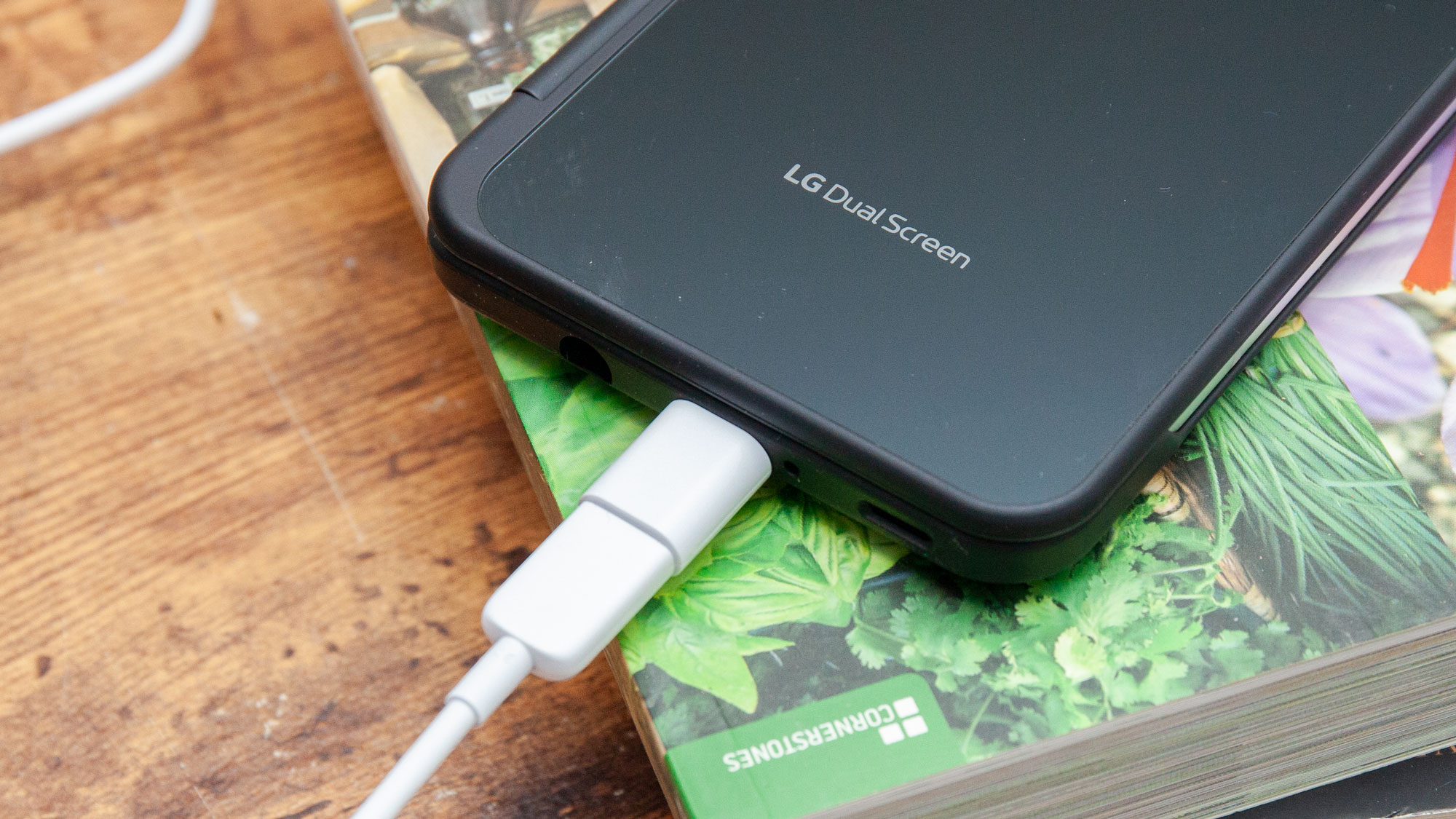
LG V60 battery
The V60 packs a 5,000mAh battery, which gets you through a day of ordinary usage, with change. In terms of sheer capacity, this is on par with the Samsung Galaxy S20 Ultra.
As mentioned, running both displays (at or over 50% brightness) drains the battery faster. In practical terms, this means watching a standard hour-long episode of a Netflix show saps around 12% battery – but when we used the Dual Screen menu to put the main screen to sleep (which dims it as much as possible), a one-hour show only drained 6%.
For recharging, the V60 comes with a FastCharge 4.0 charger in the box, which LG claims gets you 18 hours of use (or 50% capacity) from 30 minutes of charge. As an Android phone, the V60 tells you how long until a full charge when you plug it in. When we plugged the standard charger into the V60 when it was down to 16%, the phone noted it would take just over an hour and a half to charge back to full.

Buy it if…
You want more screen at a lower price
Let’s face it: foldables are too expensive for most of us, and the only way we’re going to get more display space is by unique phones like the LG V60. If you want more screen, even to just have two apps open at once, the V60 is a great option.
You want a cheaper 5G phone
Yes, the V60 has more to offer outside of its Dual Screen. The phone is 5G-capable in the sub-6 frequencies, though some versions also support mmWave – but it’s notably cheaper than similar-sized big 5G phones regardless.
You like watching media on your phone
The Dual Screen is useful for multitasking and gaming, but we found it best as a media watching assistant that
Don’t buy it if…
You want the highest-spec phone out there
The LG V60 has great specs, but it’s edged out by the Samsung Galaxy S20 line, which has both a higher-resolution display (WQHD+, 3200 x 1440), more RAM (12GB), and better storage (512GB max).
You like phone photography
Again, the LG V60’s cameras are beaten by the Samsung Galaxy S20 series, especially with the latter’s baseline 30x digital zoom. While LG’s phone has an underrated macro lens, there haven’t been enough of those around to really convince consumers they’re superior to telephoto lenses.
You want a seamless large display
The LG V60 and Dual Screen offer more display space, but they don’t have the seamless experience of foldable phones. Foldables aren’t just superior because they’re gapless, either: their software enables apps to spread across the unfolded screen in a much more fluid way. The LG V60 is an either/or phone with just one app on each display.
- Get the best deal on LG products with our LG coupon codes.
David is now a mobile reporter at Cnet. Formerly Mobile Editor, US for TechRadar, he covered phones, tablets, and wearables. He still thinks the iPhone 4 is the best-looking smartphone ever made. He's most interested in technology, gaming and culture – and where they overlap and change our lives. His current beat explores how our on-the-go existence is affected by new gadgets, carrier coverage expansions, and corporate strategy shifts.
